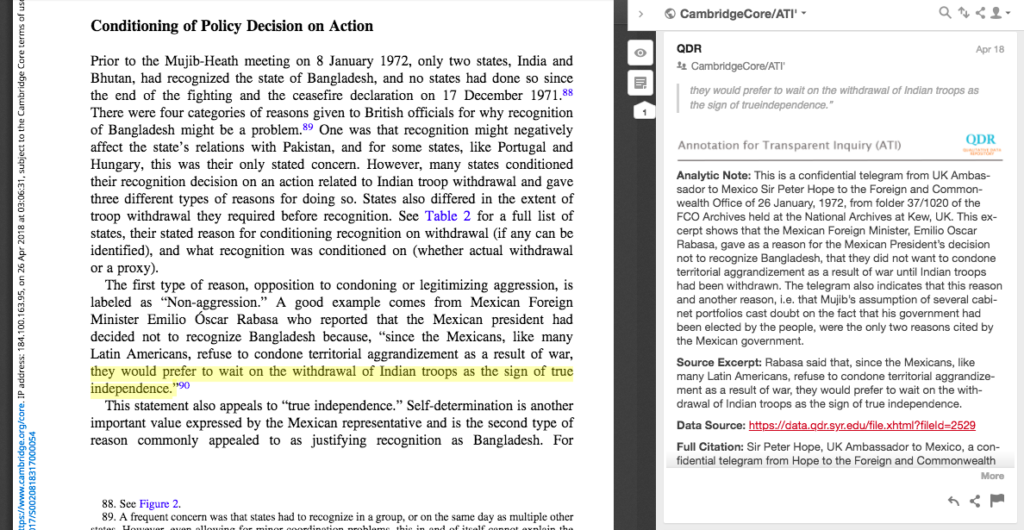Increasing Openness in Qualitative Research With QDR and Cambridge University Press

Cambridge University Press (the Press) has partnered with the Qualitative Data Repository (QDR) and Hypothesis to pioneer a new approach to making qualitative and multi-method research more transparent: Annotation for Transparent Inquiry (ATI).
ATI creates a digital overlay on top of articles on publisher web pages that connects specific passages of text to author-generated annotations. These annotations include ‘analytic notes’ discussing data generation and analysis, excerpts from data sources, and links to those sources stored in trusted digital repositories. Readers are able to view annotations immediately alongside the main text, removing the need to jump to footnotes or separate appendices. Sharing the data sources via a secure repository ensures that they are findable, accessible, interoperable, reusable, and preserved for the long term, and that human participants are protected.
Employing ATI enhances publications based on qualitative research, empowering scholars to show the qualitative data and analysis on which their work is based, making it more easily understood and evaluated.

The ATI technique can be seen in action for the first time here.
QDR co-directors Colin Elman and Diana Kapiszewski note that “ATI meets a crucial need in qualitative and mixed-method scholarly publications, increasing research transparency by providing professionally curated data and materials that were used by the author.”
“Hypothesis is honored to be a part of this groundbreaking project,” notes Heather Staines, Director of Partnerships for Hypothesis. “As an academic, I appreciate the precise nature of deep linking through annotation and the ability for researchers to augment the citation with additional information including translation and supplemental information.”
Eight articles published in leading Cambridge University Press journals from across the social and health sciences have been annotated by their authors using ATI. Brigitte Shull, Director of Scholarly Communications Research and Development at the Press, said: “Cambridge University Press is committed to helping our authors to make their research more open and reproducible. ATI is an incredibly exciting development that furthers transparency in fields that use qualitative and mixed-methods, and we are proud to be working alongside the QDR and Hypothesis to push the boundaries of how research is consumed, understood, and built upon.”
The eight Cambridge University Press articles were annotated as part of the ATI Initiative, which includes a workshop series supported by the Robert Wood Johnson Foundation, as well as by the National Science Foundation. The ATI Initiative is intended to encourage the early adoption of ATI by research communities, and engineer requirements for service models and technical features that support authors who use ATI to increase openness in qualitative research.
Read more about ATI on the QDR blog.
About Cambridge University Press
Cambridge University Press is part of the University of Cambridge. It furthers the University’s mission by disseminating knowledge in the pursuit of education, learning and research at the highest international levels of excellence. Its extensive peer-reviewed publishing lists comprise 50,000 titles covering academic research and professional development, as well as school-level education and English language teaching. Playing a leading role in today’s international marketplace, Cambridge University Press has more than 50 offices around the globe, and it distributes its products to nearly every country in the world.
About the Qualitative Data Repository
QDR is a domain repository dedicated to curating, preserving and publishing the data underlying qualitative and multi-method research in the health and social sciences. Its operations are supported by the National Science Foundation. For further information about ATI, please contact QDR’s Associate Director, Sebastian Karcher.